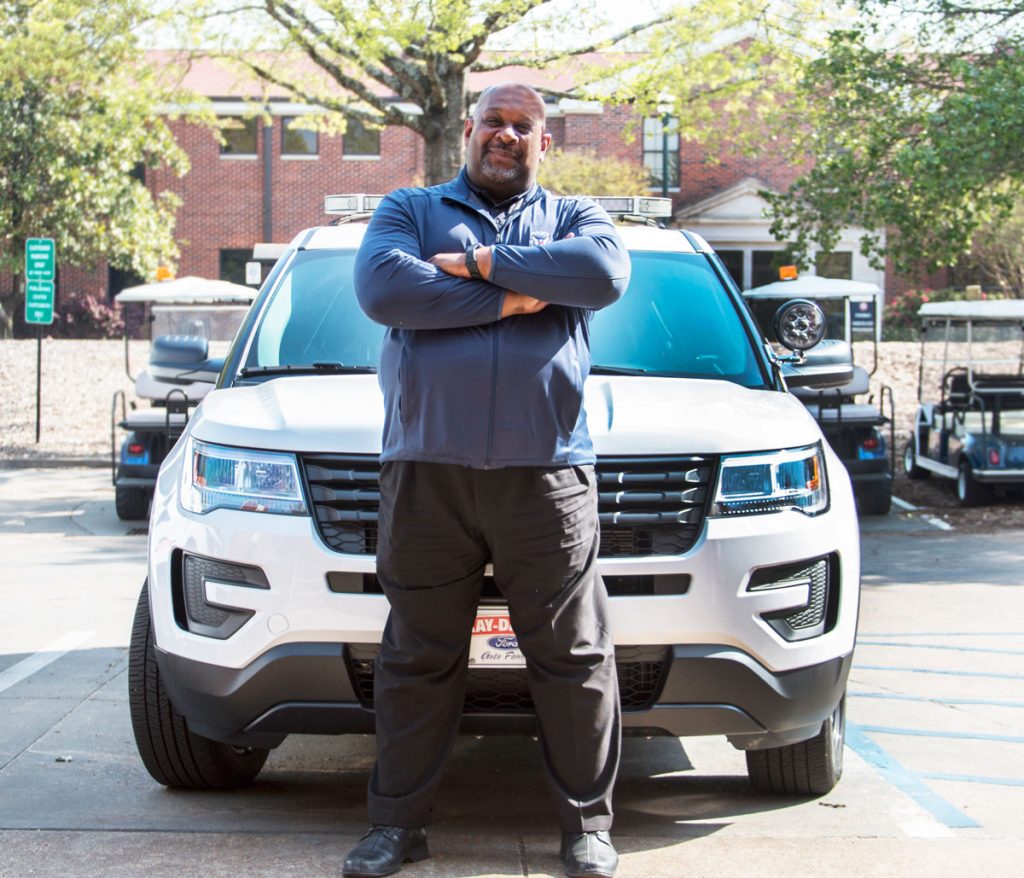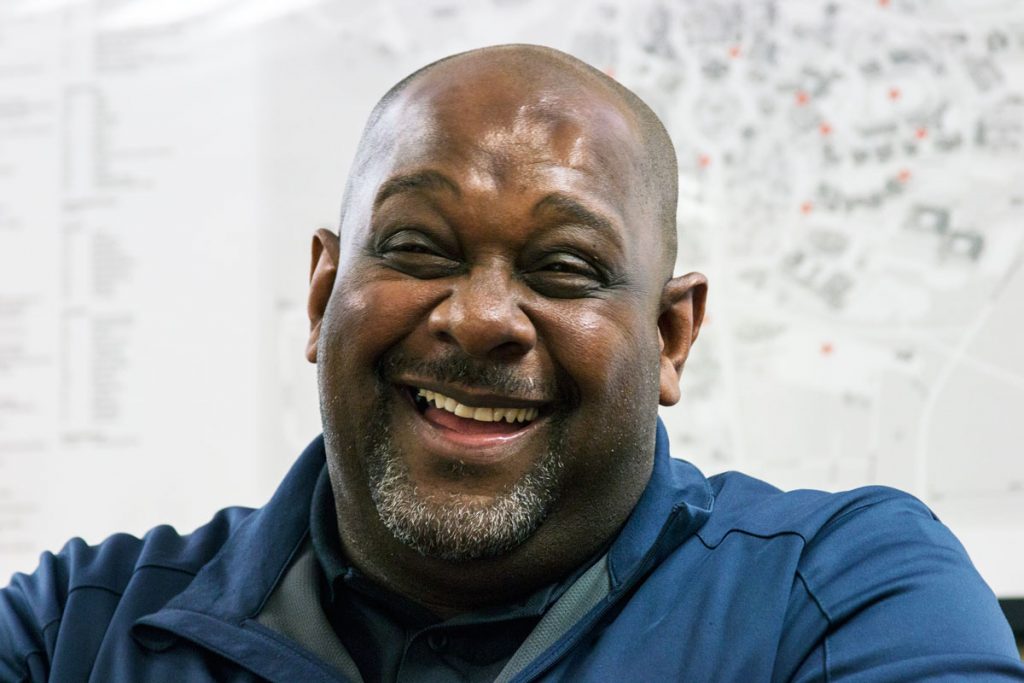Ray Hawkins has worked closely with students at Ole Miss as a member of the University Police Department for more than two decades and has now transitioned to his new position as UPD chief.
After a hiring search spanning nearly two months, the university announced April 1 that Hawkins had been selected for the job.
He began his career with UPD as a patrolman in December 1996 and several years later graduated from Ole Miss in 2001 with a bachelor’s degree in public administration with an emphasis in criminal justice.
“I started here years ago. I left school, had a family and got into law enforcement and decided it was a good time to go back to school,” Hawkins said. “The opportunity presented itself to come here, so I came here. Of course, the university has some educational benefits that were really helpful, so I was able to utilize those benefits to finish my degree.”

Ray Hawkins stands in front of a University Police Department vehicle. Hawkins was recently named the newest Chief of Police. Photo by Billy Schuerman
Having worked and been a part of the Ole Miss community for 22 years, Hawkins has seen plenty of innovation at the university.
“I’ve been here for a long time, so I’ve had the chance to see a lot of different things here on campus and see the university grow not only in facilities but in the student population,” Hawkins said.
Hawkins said he has seen new buildings like the Gertrude C. Ford Center, The Pavilion and the Robert C. Khayat Law School go up and other buildings like Miller and Guess Hall go down.
One event that sticks out in his mind is a Hurricane Katrina fundraiser on campus in 2005.
“Right after Katrina, another sort of big event was Mississippi Rising, which was a concert held at the Tad Smith Coliseum,” Hawkins said. “It was a relief concert for Hurricane Katrina, so that event drew a lot of big stars to our campus. I can remember Faith Hill and Samuel L. Jackson.”
Another notable event Hawkins witnessed and assisted with was the first presidential debate of the 2008 election between former President Barack Obama and Sen. John McCain on the Ole Miss campus.
“I was assistant chief during that time, and we were transitioning between chiefs, so I volunteered to serve as the security liaison for the university and sort of coordinate security in conjunction with the Secret Service for the presidential debate, so that was a big one,” Hawkins said.
Hawkins said the best part of his job is working with students and helping them grow and develop.
“That’s the thing about our population – the faces change, but they’re still going to be between 17 and 25, with some even older,” Hawkins. “So they’re going to be young adults, and they’re still going to bring the challenges that young adults bring. And, of course, they’re going to bring the successes that young adults bring.”
He said UPD rarely has to deal with bad student behavior and that only a small percentage of students fall into that category.
“For the most part, the interactions that we have with our students, they’re good,” Hawkins said. “I would say that 95 percent of our students are devoted to their studies, and they don’t really have an encounter with UPD.”

Ray Hawkins talks about his life prior to being named the Chief of Police at Ole Miss. Hawkins served four years in Water Valley before moving to Oxford. Photo by Billy Schuerman
Hawkins is from Water Valley and still lives there near his family with his wife of almost 30 years, Kathleen. They have twin sons who are in their 30s and a 17-year-old daughter. One son, Brandon, is a barber and the other, Raymond, is the assistant vice president of operations at Mechanics Bank. Hawkins’ daughter, Ta`Nia, is a junior at Water Valley High School.
Having worked for the Water Valley Police Department for five-and-a-half years before joining UPD, Hawkins has seen the ways law enforcement functions in a small town versus on a university campus.
“I guess both sides have their benefits and rewards,” Hawkins said. “You can really see the impact. There was a time maybe 15 or 16 years ago when I was supervisor of our housing unit, so every night from 10 p.m. to 6 a.m., I was in the residential halls.”
He still hears from some of those students all these years later. Several former students even called Hawkins to congratulate him when they found out he had been promoted to chief.
“Those are the relationships that you can build by being in this environment,” Hawkins said. “And I know because they still have and affection for me and they still check on me. I know that at some point, some way, somehow, I impacted them.”
He said one of the challenges that comes along with working with young people on a college campus is helping officers understand the dynamic between themselves and students and how they fit in with the university’s overall environment.
“Our officers, they go to the same police academy, receive the same certification as an officer anywhere in the state of Mississippi, but the way we police is a little bit different,” Hawkins said. “We’re so focused on community policing and relationship-building that you have to really understand what our objective is here.”

Ray Hawkins talks about his life prior to being named the Chief of Police at Ole Miss. Hawkins served four years in Water Valley before moving to Oxford. Photo by Billy Schuerman
Hawkins uses the phrase “education before enforcement” as a way to explain to officers that students do make mistakes, but while they’re receiving an education inside the classroom, they can also be educated outside of it. Hawkins said that outside education is what UPD can contribute to by helping students understand the ramifications of their behavior and giving them information to make better decisions moving forward.
He said the department is hoping to increase its social media presence in an effort to reach students and keep them informed about what UPD is doing in the community.
“I have a 17-year-old daughter,” Hawkins said. “She doesn’t call me to tell me anything. If she wants to talk, she texts, so in order to communicate with students, you’ve got to use the same medium that they’re using to communicate.”
The most rewarding part of the job for Hawkins is and always has been the ability to help people.
“Police work is about a life of service, and when you devote yourself to wanting to serve the community, then you really want to know that, at the end of the day, you made a difference,” Hawkins said. “Some officers don’t really experience it their whole career, but I can see it almost daily. (You see it) when you come in contact with students and you have conversations and see how they light up and interact.”






